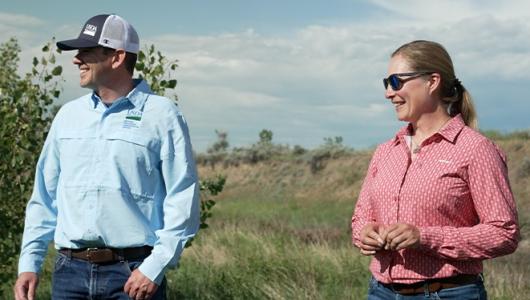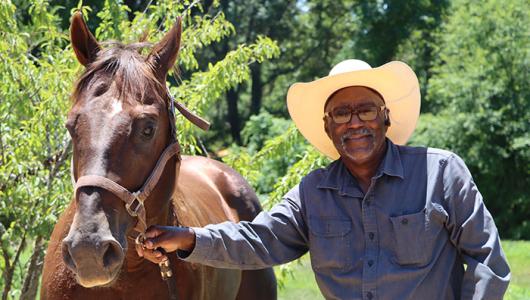From the kitchen table to the boardroom table, USDA brings people together across the nation for: healthier food, natural resources and people; a stronger agricultural industry; and economic growth, jobs and innovation.
Each Friday, meet those farmers, producers and landowners through our #FridaysOnTheFarm stories. Visit local farms, ranches, forests and resource areas where USDA customers and partners do right and feed everyone.
This Friday, meet David Sceirine, who is protecting key wildlife habitat on his family's ranch near Bridgeport Valley, California. David and his brother Joe enrolled 2,375 acres into a conservation easement, safeguarding Sceirine Point Ranch from future development while helping the Bi-State sage-grouse, an at-risk bird that lives at the Nevada-California line where they ranch.
Click here to read the interactive, multimedia #FridaysOnTheFarm story.
Prime Land to Protect
For the brothers, who are carrying on a family tradition of ranching, the easement made sense.
While developers eyed the ranch for subdivisions, conservationists were eyeing it for a different reason: it is prime Bi-State sage-grouse habitat. The ranch is home to this geographically distinct population of the greater sage-grouse that reside only along the California-Nevada state line.
Ranchers in the region, including the Sceirines, are working with their local conservation partners to restore and protect key habitat, which also benefits their ranching operation and their local community.
The ranch has 1,810 acres of wet and semi-wet meadows and irrigated pasture on the property, which sage grouse need for raising their young.
Conservation Easement
An agricultural land easement protects land perpetually while still enabling the Sceirines to continue working the land.
The Sceirines enrolled the land into the Agricultural Conservation Easement Program, a Farm Bill funded program offered by USDA’s Natural Resources Conservation Service. The California Deer Association and California Department of Conservation also provided funding for the easement.
The Eastern Sierra Land Trust holds the easement, and it's one of the land trust’s largest. “Sage grouse and mule deer don’t see property ownership lines. For the animals that use this property, the ideal situation is they cross from private lands to public lands, and they don’t know the difference,” the land trust’s Susanna Danner said.
Other Conservation Efforts
In addition to the easement, the Sceirines have made other conservation improvements to their land to enhance it both for ranching and for wildlife. They use rotational grazing to prevent overgrazing and to improve rangeland health.'
"If you follow a sage grouse hen around, they like to follow the cows," said David. "After the cows graze, the grasses are shorter, making the bugs easier for them to get.”
The Sceirines have also worked with the Natural Resources Conservation Service to remove invading conifers, which degrade sagebrush habitat and provide perches for raptors that prey on sage grouse.
Additionally, the brothers use water wisely on their ranch. Sceirine Point Ranch is part of a watershed irrigation system, meaning when they irrigate their land, the water trickles down and benefits other ranches.
“Your whole community benefits when your ranchers and farmers do better,” David said. “Our whole nation benefits. And education is the key. When you know better, you do better.”
USDA Assistance
The Natural Resources Conservation Service helped the Sceirines plan and implement prescribed grazing, irrigation improvements, and other conservation practices over the years.
USDA offers a variety of risk management, disaster assistance, loan, and conservation programs to help agricultural producers in the United States. Learn about additional programs.
For more information about USDA programs and services, contact your local USDA service center.
Join the Conversation
Follow the #FridaysOnTheFarm story series and other news you can use on farmers.gov and our social media channels: Twitter, Instagram, YouTube, Flickr, and Facebook.
Story: Heather Emmons, Natural Resources Conservation Service
Photos: Eastern Sierra Land Trust; Conservation Media; Claudia Strijek; Ken Miracle; Heather Emmons and Jeremy Maestas, Natural Resources Conservation Service


